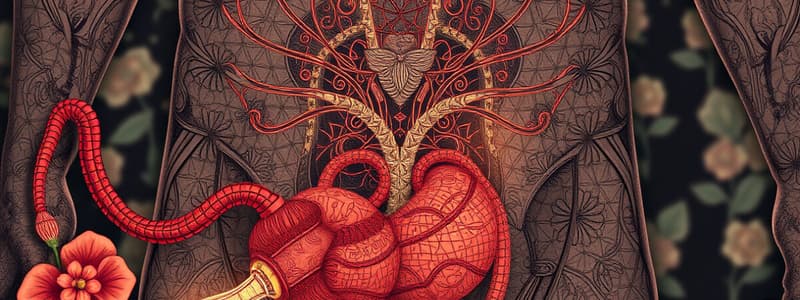Podcast
Questions and Answers
What skin bag covers the testes?
What skin bag covers the testes?
Scrotum
What are the two types of cells found in the testes?
What are the two types of cells found in the testes?
- Sertoli cells
- Leydig cells
- Both A and B (correct)
- Germinal cells
Elevated levels of FSH and LH lead to the male pattern of development before birth.
Elevated levels of FSH and LH lead to the male pattern of development before birth.
True (A)
What is a typical normal sperm count per ml?
What is a typical normal sperm count per ml?
What is the function of Leydig cells?
What is the function of Leydig cells?
What is the surgical removal of part of the prepuce called?
What is the surgical removal of part of the prepuce called?
The condition in which there are undescended testes is called ______.
The condition in which there are undescended testes is called ______.
What is the common age range for testicular tumors to peak?
What is the common age range for testicular tumors to peak?
Balanitis is an inflammation of the glans surrounding the penis head.
Balanitis is an inflammation of the glans surrounding the penis head.
Prostatitis can be caused by ______ infections.
Prostatitis can be caused by ______ infections.
What is the most common benign condition affecting older males?
What is the most common benign condition affecting older males?
What is the causative organism for syphilis?
What is the causative organism for syphilis?
Which serologic test for syphilis becomes positive 1-2 weeks after infection?
Which serologic test for syphilis becomes positive 1-2 weeks after infection?
Flashcards are hidden until you start studying
Study Notes
Male External Genitalia
- Scrotum: A skin pouch that encases the testes, supporting temperature regulation for sperm production.
- Testes: Paired organs responsible for producing germ cells; contain Leydig cells (testosterone production) and Sertoli cells (spermatogenesis).
- Hormonal Influence: Elevation of FSH and LH occurs before birth, leading to male development, with changes such as genital enlargement and secondary sex characteristics starting at puberty.
Spermatogenesis and Semen
- Semen Composition: A mixture of sperm (2.5-5 ml per ejaculation) and seminal fluid.
- Sperm Count: Normal range is 50-150 million sperm/ml; infertility is defined by a count below 20 million/ml.
- Vasectomy: A surgical procedure that involves cutting the vas deferens to prevent sperm release.
Penis Functionality
- Erection Process: Induced by parasympathetic stimulation affecting penile blood vessels.
- Ejaculation Process: Triggered by sympathetic reflex leading to vasoconstriction during the expulsion of semen.
Circumcision
- A surgical procedure that removes part of the foreskin to prevent accumulation of fluid and potential infection under the skin folds.
Cryptorchidism
- A condition marked by undescended testes, prevalent in 3% of full-term and 30% of premature infants.
- Spontaneous Descent: 80% of cases resolve within the first year.
- Cancer Risk: Men with this condition have a 30-50 times higher risk for testicular cancer.
Puberty
- Gonadotropin secretion in newborns is initially high but falls; it rises again at the onset of puberty, signaling increased levels of FSH and LH.
Inflammatory Lesions
- Balanitis: Inflammation of the glans, commonly seen in uncircumcised males due to smegma accumulation. Can lead to phimosis (inability to retract foreskin) or paraphimosis (tightness after retraction).
- Penile Carcinoma: Predominantly squamous cell carcinoma (95%) characterized by slow growth, persistent lesions, and association with HPV types 16 and 18.
Testicular Tumors
- Common cause of painless testicular masses, primarily affecting males aged 15-34.
- Types: 95% are germinal cell tumors, with seminoma being the most prevalent.
- Markers: Elevated Human Chorionic Gonadotropin (hCG) and Alpha-fetoprotein (AFP) indicate malignancy.
Prostatitis
- Acute Prostatitis: Caused by ascending bacterial infections, often with a neutrophilic infiltrate.
- Chronic Prostatitis: Characterized by lymphocytic infiltrate; often caused by less virulent bacteria, leading to negative cultures.
- Symptoms: Increased urination, hematuria, nausea, fever, and abdominal pain.
- Treatment Options: Antibiotics (Ceftriaxone, Ciprofloxacin) and muscle relaxants (Tamsulosin).
Benign Prostatic Hypertrophy (BPH)
- Affects over 90% of the elderly male population, leading to urinary frequency and retention, with no malignant potential.
- Composition: Characterized by fibrous tissue and epithelium hyperplasia.
- Treatment: Monitoring, drug therapies (alpha blockers), and intervention like transurethral resection (TURP).
Prostatic Adenocarcinoma
- The most common visceral neoplasm in men, often linked with age (peak incidence at 65+).
- Latent Lesions: Found in over 50% of men aged 80.
- Palpability: Most arise in the peripheral zone of the prostate, detectable during rectal exams.
Syphilis
- Caused by Treponema pallidum; characterized by three stages: primary (chancre), secondary (mucocutaneous lesions), and tertiary (cardiovascular/neurosyphilis).
- Testing: Serologic tests include VDRL, RPR, and FTA-ABS; positive results indicate infection after several weeks.
- Treatment Options: Penicillin G for standard treatment; alternatives for penicillin allergy include Doxycycline and Azithromycin.
Gonorrhea
- Caused by Neisseria gonorrhoeae, presenting with purulent urethral discharge.
- Complications: Can lead to mucopurulent conjunctivitis.
- Diagnosis: Culture or PCR tests used for confirmation of infection.
Studying That Suits You
Use AI to generate personalized quizzes and flashcards to suit your learning preferences.




